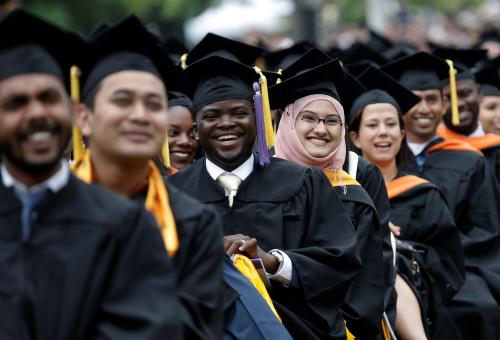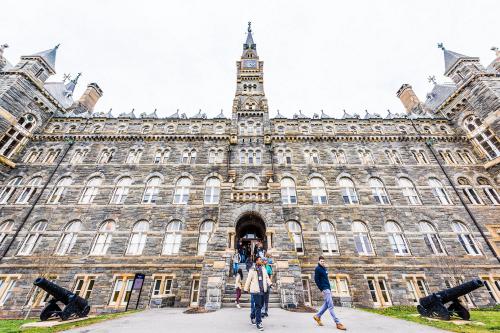This story was produced by The Hechinger Report, a nonprofit, independent news organization focused on inequality and innovation in education.
Standardized tests that are used for the purposes of college admissions don’t predict college success very well. Scores on the widely used SAT and ACT tests only predict adequately for grades earned in a student’s first year in college. And those scores are worse predictors for black and brown students. For what it’s worth, scores from the SAT and ACT tests are good proxies for the amount of wealth students are born into: income tracks with test performance. The more money a student’s parents make, the more likely he or she will have a higher score. It follows, then, that the less money you make, the more likely you’ll be denied a chance at a selective institution. And unfortunately, the divide between the rich and the poor is widening. The achievement gap between those who make less than $80,000 and those who make more than that amount has increased from 2012 to 2016, according to a 2016 ACT report.
This is all troubling for the future of our youth, particularly for students on the wrong side of the household income divide. To confront these obstacles to success, at least one testing company is trying (sort of) to eliminate the barrier of income.
On May 16, The Wall Street Journal reported that the College Board, the not-for-profit company that prepares the SAT, will assign an adversity score to each student who takes the college admissions exam. The score is made up of 15 factors, including neighborhood and demographic characteristics, including crime rate and poverty. The adversity score doesn’t take into account the race of the student. The Wall Street Journal reported that 50 colleges used the score last year and 150 will use it in the fall. College admissions officials are privy to the adversity scores, not the students.
Test score differences are a symptom of systemic discrimination, which robs black and brown communities of wealth-building opportunities. Attempts at addressing the wealth gap, which stems from the history of slavery, segregation, racism and discrimination, should be encouraged and lauded. I’m all for acknowledging wealth disparities wherever we can, but policymakers and institutional leaders shouldn’t forget that programs that directly attempt to close the wealth gap will have more bearing on how students score on a standardized test. We should be trying to level the playing field by providing historically disenfranchised people opportunities to build wealth rather than retrofitting test results around inequality.
Researchers, including those who work for the test companies, have known wealth is strongly correlated with outcomes on standardized tests for years. There are several reasons why. Wealthy students attend higher ranked schools within more financially resourced districts. Richer families can afford more tutoring, test prep and enrichment activities. The College Board never claimed that test prep could improve scores until it was available for free online, at which point the evidence of improvement came rolling in. Standardized tests are better proxies for how many opportunities a student has been afforded than they are predictors for students’ potential. Consequently, tests weed out budding low-income students instead of creating equitable access to institutions that help build wealth. This is why many colleges have abandoned using standardized test altogether. But ignoring test scores won’t make wealth gaps disappear. We must go to the source of the problem.
We should be trying to level the playing field by providing historically disenfranchised people opportunities to build wealth rather than retrofitting test results around inequality.
According to the Federal Reserve’s most recent numbers in 2016, based on the Survey of Consumer Finances, white families had the highest median family wealth at $171,000, compared to black and Hispanic families, which had $17,600 and $20,700, respectively.
The wealth gap—caused mostly by racism—undoubtedly has a bearing on educational outcomes. As SAT scores assign a numeric value to nearly every college-bound senior in the country, they provide a glimpse into how race and socioeconomic class impact educational outcomes for students. The College Board releases average scores on a yearly basis across various levels of income, race, and levels of parental education, among other categories. The three charts below reflect those national averages for the 2018 test, except in the case of family income level, for which 2016 data are the latest available. SAT scores from 2016 have been converted to the 2018 scale. In sum, these charts show the interrelatedness of wealth and educational outcomes.



Students can’t pick their parents, but policy can level the playing field. For the efforts of the College Board to have a serious effect, they must complement true wealth building opportunities. For instance, Darrick Hamilton, who serves as the director of Ohio State University’s Kirwan Institute for the Study of Race and Ethnicity, and Duke professor William Darity proposed what they coined “baby bonds” as an attempt to reduce wealth inequality among Americans. Every child born in the U.S. would receive $1,000 in a bonded savings account run by the Treasury Department. Each year, the government would make contributions based off each family’s size and income. The lower a family’s income, the greater the contribution would be. Children would receive an average of $25,000 upon turning 18. Those from the poorest backgrounds could expect as much as $60,000 according to Bloomberg. The money would then be restricted to wealth-building activities such as attending school, starting a business, or purchasing a home. The program would cost less than 3 percent of the federal budget.
Students who have been disenfranchised by racism need more than an adjustment to a standardized test. Students can’t eat a test score. They can however feed themselves if given the same opportunities for wealth that was bestowed upon their white peers.
The Brookings Institution is committed to quality, independence, and impact.
We are supported by a diverse array of funders. In line with our values and policies, each Brookings publication represents the sole views of its author(s).







Commentary
Students need more than an SAT adversity score, they need a boost in wealth
May 17, 2019